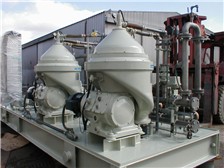Post by: Dayele
Most Americans use is either oil or natural gas for energy. A supply and demand imbalance is currently driving up the costs of both oil and natural gas. Americans are demanding more energy and as this demand increases, our supply of oil and natural gas hasn’t increased especially from domestically available resources. Actually,
 this production is on the decline. It is time to start exploring and tapping new supplies of oil and natural gas here in America.
this production is on the decline. It is time to start exploring and tapping new supplies of oil and natural gas here in America.Oil is a worldwide commodity. Prices are bound to rise worldwide with the increased competition/demand and the present stagnant production.
Higher prices are also a result of supply disruption "fears" from potential hot spots in the Middle East, Venezuela, and Russia. Worldwide spare capacity has reduced dramatically from 10 million barrels per day a decade ago to about 2 million barrels per day today.
The natural gas used in the United States is primarily from North American resources. Importing natural gas in a liquefied state from overseas hasn’t yet been fully developed. Natural gas is a preferred fuel choice that powers most new homes and buildings, as well as power plants mainly because it is clean-burning. Inconsistent government policies and regulations have discouraged the exploration and production of new domestic gas supplies. This creates another supply-demand imbalance. Because the increase in natural gas demand isn't being met with new supplies, prices for natural gas rise too.
Some other reasons for the rising costs of natural gas and oil include: weather (cold weather will increase demand), hurricanes (can stop production in the Gulf of Mexico), litigation and regulations, lack of public support and government encouragement for new oil and gas wells, Geopolitical unrest around the world, and market speculation.
The consequences of no new domestic production makes for fluctuation in consumer prices. Some of our factories are moving their businesses overseas to take advantage of cheaper energy costs meaning lost jobs and lost tax and royalty revenue. Today, 63% of our oil is imported today which is a high reliance on foreign countries, taking on a national and economic security risk. Having the supply controlled by other countries, of course, is not ideal. Plus the extremely high national trade deficit (one-third of which is represented in oil imports) has to stop soaring.
The fuel industry needs to re-look at the federal policy recognizing the importance of domestic oil and natural gas. Some suggested changes are: allowing access to non-park, non-wilderness federal lands where abundant, lower cost domestic oil and gas is located, providing for more offshore oil and gas exploration, stopping unnecessary law suits and regulations, providing full federal funding for government agencies that have industry oversight and for oil and gas technology programs to do research, encouraging students to get involved in order to develop a new workforce for the coming years, and offering credits for unconventional resources to be used instead.
Currently, in the United States, there are about 5,000 independent oil and natural gas producers. Independents can be small family companies or publicly traded companies. They operate in 33 states and the offshore. Companies like Triple Diamond Energy Corporation drill 90 percent of the wells here and produce 68 percent of America's oil and 82 percent of domestic natural gas.
Chris Jent is the Chief Marketing Officer of Triple Diamond Energy Corp. Triple Diamond Energy specializes in acquiring the highest quality prime oil and gas properties. For more information, visit http://www.triplediamondenergycorp.blogspot.com.
This article is free for republishing
Source: http://www.articlealley.com/
The natural gas used in the United States is primarily from North American resources. Importing natural gas in a liquefied state from overseas hasn’t yet been fully developed. Natural gas is a preferred fuel choice that powers most new homes and buildings, as well as power plants mainly because it is clean-burning. Inconsistent government policies and regulations have discouraged the exploration and production of new domestic gas supplies. This creates another supply-demand imbalance. Because the increase in natural gas demand isn't being met with new supplies, prices for natural gas rise too.
Some other reasons for the rising costs of natural gas and oil include: weather (cold weather will increase demand), hurricanes (can stop production in the Gulf of Mexico), litigation and regulations, lack of public support and government encouragement for new oil and gas wells, Geopolitical unrest around the world, and market speculation.
The consequences of no new domestic production makes for fluctuation in consumer prices. Some of our factories are moving their businesses overseas to take advantage of cheaper energy costs meaning lost jobs and lost tax and royalty revenue. Today, 63% of our oil is imported today which is a high reliance on foreign countries, taking on a national and economic security risk. Having the supply controlled by other countries, of course, is not ideal. Plus the extremely high national trade deficit (one-third of which is represented in oil imports) has to stop soaring.
The fuel industry needs to re-look at the federal policy recognizing the importance of domestic oil and natural gas. Some suggested changes are: allowing access to non-park, non-wilderness federal lands where abundant, lower cost domestic oil and gas is located, providing for more offshore oil and gas exploration, stopping unnecessary law suits and regulations, providing full federal funding for government agencies that have industry oversight and for oil and gas technology programs to do research, encouraging students to get involved in order to develop a new workforce for the coming years, and offering credits for unconventional resources to be used instead.
Currently, in the United States, there are about 5,000 independent oil and natural gas producers. Independents can be small family companies or publicly traded companies. They operate in 33 states and the offshore. Companies like Triple Diamond Energy Corporation drill 90 percent of the wells here and produce 68 percent of America's oil and 82 percent of domestic natural gas.
Chris Jent is the Chief Marketing Officer of Triple Diamond Energy Corp. Triple Diamond Energy specializes in acquiring the highest quality prime oil and gas properties. For more information, visit http://www.triplediamondenergycorp.blogspot.com.
This article is free for republishing
Source: http://www.articlealley.com/












